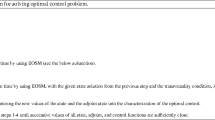Abstract
We investigate a class of optimal control problems that exhibit constant exogenously given delays in the control in the equation of motion of the differential states. Therefore, we formulate an exemplary optimal control problem with one stock and one control variable and review some analytic properties of an optimal solution. However, analytical considerations are quite limited in case of delayed optimal control problems. In order to overcome these limits, we reformulate the problem and apply direct numerical methods to calculate approximate solutions that give a better understanding of this class of optimization problems. In particular, we present two possibilities to reformulate the delayed optimal control problem into an instantaneous optimal control problem and show how these can be solved numerically with a state-of-the-art direct method by applying Bock’s direct multiple shooting algorithm. We further demonstrate the strength of our approach by two economic examples.
Similar content being viewed by others
References
Altuǧ S. (1993). Time-to-build, delivery lags, and the equilibrium pricing of capital goods. Journal of Money, Credit and Banking 25, 301–319
Asea P.K., Zak P.J. (1999). Time-to-build and cycles. Journal of Economic Dynamics and Control 23, 1155–1175
Bauer, I. (1999). Numerische Verfahren zur Lösung von Anfangswertaufgaben und zur Generierung von ersten und zweiten Ableitungen mit Anwendungen bei Optimierungsaufgaben in Chemie und Verfahrenstechnik. Ph.D. Thesis, Universität Heidelberg.
Bellman R., Cooke K.L. (1963). Differential-difference equations. New York, Academic Press
Benhabib J., Rustichini A. (1991). Vintage capital, investment, and growth. Journal of Economic Theory 55, 323–339
Bock, H. G., & Plitt, K. J. (1984). A multiple shooting algorithm for direct solution of optimal control problems. In Proceedings 9th IFAC World Congress budapest. Pergamon Press, pp. 243–247.
Bock, H. G., & Schlöder, J. P. (1984). Numerical computation of optimal controls in the presence of state-dependent time lags. In Preprints 9th IFAC World Congress Budapest, Vol. IX. IFAC, pp. 108–113.
Boucekkine R., de la Croix D., Licandro O. (2002). Vintage human capital, demographic trends, and endogenous growth. Journal of Economic Theory 104, 340–375
Boucekkine R., de la Croix D., Licandro O. (2004). Modelling vintage structures with DDEs: Principles and applications. Mathematical Population Studies 11, 151–179
Boucekkine R., Germain M., Licandro O. (1997b). Replacement echoes in the vintage capital growth model. Journal of Economic Theory 74, 333–348
Boucekkine R., Germain M., Licandro O., Magnus A. (1998). Creative destruction, investment volatility, and the average age of capital. Journal of Economic Growth 3, 361–384
Boucekkine R., Germain M., Licandro O., Magnus A. (2001). Numerical solution by iterative methods of a class of vintage capital models. Journal of Economic Dynamics and Control 25, 655–669
Boucekkine R., Licandro O., Paul C. (1997a). Differential-difference equations in economics: On the numerical solution of vintage capital growth models. Journal of Economic Dynamics and Control 21, 347–362
Boucekkine R., Licandro O., Puch L.A., del Rio F. (2005). Vintage capital and the dynamics of the ak model. Journal of Economic Theory 120, 39–72
Boyer M. (1978). A habit formation optimal growth model. International Economic Review 19, 585–609
Carroll C.D., Overland J., Weil D.N. (2000). Saving and growth with habit formation. American Economic Review 90, 341–355
Collard, F., Licandro, O., & Puch, L. A. (2004). The short-run dynamics of optimal growth models with delays. Discusion-Paper No. eco 2004/04. European University Institute.
De la Croix D., Licandro O. (1999). Life expectancy and endogenous growth. Economics Letters 65, 255–263
Driver R.D. (1977). Ordinary and delay differential equations. Heidelberg, Springer
El-Hodiri M.A., Loehman E., Whinston A. (1972). An optimal growth model with time lags. Econometrica 40, 1137–1146
Gandolfo, G. (1996). Economic dynamics. Berlin: Springer. Dritte, komplett überarbeitete und erweiterte Auflage.
Hale J. (1977). Theory of functional differential equations. New York, Springer
Kalecki M. (1935). A macroeconomic theory of business cycles. Econometrica 3, 327–344
Kolmanovskii V.B., Myshkis A.D. (1999). Introduction to the theory and applications of functional differential equations. Dordrecht, Kluwer
Kolmanovskii V.B., Nosov V.R. (1986). Stability of functional differential equations. London, Academic Press
Kydland F.E., Prescott E.C. (1982). Time to build and aggregate fluctuations. Econometrica 50, 1345–1370
Leineweber, D. B. (1999). Efficient reduced SQP methods for the optimization of chemical processes described by large sparse DAE models. Fortschritt-Berichte VDI Reihe 3, Verfahrenstechnik, Vol. 613. Düsseldorf: VDI Verlag.
Leineweber D.B., Bauer I., Bock H.G., Schlöder J.P. (2003). An efficient multiple shooting based reduced SQP strategy for large-scale dynamic process optimization. Part I: Theoretical aspects. Computers and Chemical Engineering 27, 157–166
Peeters M. (1996). Investment gestation lags: The difference between time-to-build and delivery lags. Applied Economics 28, 203–208
Plitt, K. J. (1981). Ein superlinear konvergentes Mehrzielverfahren zur direkten Berechnung beschränkter optimaler Steuerungen. M.Phil. Thesis, Universität Bonn.
Rustichini A. (1989). Hopf bifurcation for functional differential equations of mixed type. Journal of Dynamics and Differential Equations 1, 145–177
Winkler, R. (2004). Time-lagged accumulation of stock pollutants. Additively separable welfare functions reconsidered. Discussion-Paper No. 408. Alfred Weber-Institute of Economics, University of Heidelberg.
Winkler, R., Brand-Pollmann, U., Moslener, U., & Schlöder, J. (2005). On the transition from instantaneous to time-lagged capital accumulation. The case of Leontief-type production functions. Discussion-Paper No. 05-30. Centre for European Economic Research (ZEW), Mannheim.
Author information
Authors and Affiliations
Corresponding author
Rights and permissions
About this article
Cite this article
Brandt-Pollmann, U., Winkler, R., Sager, S. et al. Numerical Solution of Optimal Control Problems with Constant Control Delays. Comput Econ 31, 181–206 (2008). https://doi.org/10.1007/s10614-007-9113-3
Received:
Accepted:
Published:
Issue Date:
DOI: https://doi.org/10.1007/s10614-007-9113-3




